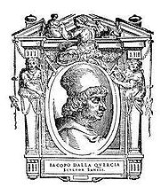
Jacopo della Quercia
Encyclopedia
Jacopo della Quercia was an Italian
sculptor of the Italian Renaissance, a contemporary of Brunelleschi
, Ghiberti
and Donatello
. He is considered a precursor of Michelangelo
.
, where he was born in 1374. He received his early training from his father, Piero d'Angelo, a woodcarver and goldsmith. Jacopo della Quercia, a Sienese, must have seen the works of Nicola Pisano
and Arnolfo di Cambio
on the pulpit in the cathedral of Siena
and this must have influenced him. His first work may have been at the age of sixteen, an equestrian wooden statue for the funeral of Azzo Ubaldini.
He left with his father to Lucca
, owing to party strife and disturbances.
In Pisa, della Quercia likely studied the huge collection of Roman sculptures and sarcophagi in the Camposanto. These and later influences made him a transitional figure in the history of European art; his work shows a pronounced midcareer shift from the Gothic style to that of the Italian Renaissance
. As in the case of Ghiberti
, this development probably results from exposure to his contemporary, Donatello
.
Della Quercia's earliest work (though this attribution is sometimes contested) appears in the Lucca cathedral: Man of Sorrows (Altar of the Sacrament) and a relief on the tomb of St. Aniello. In 1401 he entered a competition to design the bronze baptistry
doors for Florence
's cathedral, but lost to Ghiberti. The unsuccessful entry's whereabouts are unknown.
In 1403 he sculpted the marble Virgin and Child for the Ferrara
cathedral. Another (possible) work from his period in Ferrara is the statuette of St. Maurelius (both on in display in the Museo del Duomo).
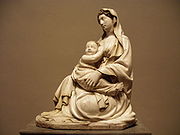 Back again in Lucca in 1406, he received the commission from the city's ruler, Paolo Guinigi
Back again in Lucca in 1406, he received the commission from the city's ruler, Paolo Guinigi
, to begin work at the tomb of his second wife Ilaria del Carretto in the Lucca cathedral
. The richly dressed woman rests on top of the sarcophagus
, delicately portrayed in a Gothic fashion, with her dog, symbol of conjugate fidelity, at her feet. But his use of several nude putti at the flanks of the tomb clearly shows the classical influence of the Roman sarcophagi at Camposanto (Pisa). This is a first, a harbinger of the incipient Renaissance.
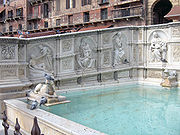
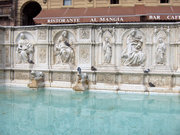
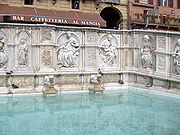 In 1406 he was asked to build a new fountain in the Piazza del Campo
In 1406 he was asked to build a new fountain in the Piazza del Campo
in Siena. It had to replace the original fountain with a statue of the goddess Venus. This pagan statue was blamed for an outbreak of the Black Plague. The statue was destroyed and buried outside the city walls to avert its "evil influence". This prestigious commission shows that he was already being recognized as Siena's most prominent sculptor. The rectangular fountain, built in white marble, was dedicated to the Virgin, adorned on the three sides by many statues and multiple spouts. Because he accepted also other commissions at the same time, progress was slow. He started in 1414 and the fountain was only finished in 1419. He carved the panels in the workshop for sculptors, next to the cathedral. This workshop is now converted into the Cathedral Museum. It was called Fonte Gaia, because of the joy and the festivities when its was brought into operation. It is now a center of attraction for the many tourists. The old statues were replaced by copies in 1858 from Tito Sarrocchi
and are now on display in the loggia of the Palazzo Pubblico.
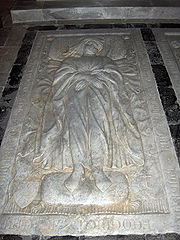 In 1412, contracted by a wealthy merchant Lorenzo Trenta, he started the design of the Trenta Chapel in the basilica of San Frediano
In 1412, contracted by a wealthy merchant Lorenzo Trenta, he started the design of the Trenta Chapel in the basilica of San Frediano
in Lucca. In 1413 he was accused, together with his assistant Giovanni da Imola, of serious crimes: theft, as well as rape and sodomy of one Clara Sembrini. He fled to Siena (and began working on the Fonte Gaia), but his assistant was incarcerated for three years. Jacopo della Quercia only would return to Lucca in March 1416, given a letter of safe conduct. He continued at the Trenta Chapel on the marble altar and several statues of saints, contained in niches. Some work was also performed by his assistant. Jacopo also designed the tomb slabs of Lorenzo Trenta and his wifze Isabetta Onesti, on the pavement in front of the altar.
When in 1416 Lorenzo Ghiberti
was asked to design a hexagonal basin with bronze panel for the Baptistery in Siena, political infighting brought Jacopo della Quercia into the project (who had been his competitor for the bronze doors in Florence). He only completed one bronze relief The Annunciation to Zacharias because he was working at the same time on the Fonte Gaia and the Trenta Chapel. His lingering on this project brought him in legal difficulties with the authorities. Since he had been rejected in the competition for the "Doors of Paradise" in Florence, he had been reluctant to work with bronze. And when he worked on the tabernacle of the baptistery, he insisted on taking care only of the marble part.
In 1421 he carved an Annunciation, in a different style, with two wooden polychromed statues Virgin and Gabriel for the Collegiata
in San Gimignano
(the polychrome finishing was done by other masters, such as Martino di Bartolomeo
). The sophistication of this group, equal to the quality of his marble statues, shows that he was also versatile in woodcarving. This led some authors to ascribe other wooden statues to him, but most are attributable to his very active workshop.
In his later years, he became even more active, working on different projects simultaneously. In 1427 he received the commission to design the upper part of the baptismal font for the Siena Baptistery. This hexagonal column, resting on a pillared base in the middle of the basin, contains five prophets situated in niches. The marble statue of St. John the Baptist, at the top of the dome above the tabernacle, is also attributed to Jacopo della Quercia.
 In 1425 he accepted another major commission : the design of the round-arched Porta Magna of the San Petronio church in Bologna
In 1425 he accepted another major commission : the design of the round-arched Porta Magna of the San Petronio church in Bologna
. It would keep him busy for a good deal of the last thirteen years of his life and it is considered his masterwork. Each side of the door is flanked, first by a colonette with a spirally wound decoration, then nine busts of prophets and at the end five scenes from the Old Testament, carved into somewhat lower relief. In the Creation of Adam, he uses the same arrangement as in the Fonte Gaia (in Siena), but in reverse order. Michelangelo
, who had visited Bologna in 1494, conceded that his Genesis in the Sistine Chapel
in the Vatican, was based on these reliefs. The architrave
above the door contains five reliefs with representations from the New Testament. The lunette
contains three free-standing statues : Virgin and Child, Saint Petronius (with a model of Bologna in his right hand) and Saint Ambrose (carved by another sculptor Domenico Aimo in 1510). Originally this third statue had to represent the papal legate Cardinal Alemmano, but this intention was quickly abandoned after the cardinal had been evicted from Bologna. He relied heavily on the artists of his Bolognese workshop, such as Cino di Bartolo, for assistance in this project.
While working at the Porta Magna, he was asked in 1434 by the Sienese to design the Loggia di San Paolo, close to the Piazza del Campo. He was not able to finish this commission. At his death he had only finished the capitals and six niches.
 In his final years he was awarded several honours by the Sienese : in 1435 he was knighted and given the important position of Operaio of the cathedral.
In his final years he was awarded several honours by the Sienese : in 1435 he was knighted and given the important position of Operaio of the cathedral.
In his final years, he was also involved in the decoration of the chapel of the Saint Sebastian (destroyed in 1645) for the cardinal Casini in the cathedral of Siena, but, part of a relief of the cardinal, most work was done by his Siena workshop. This carved high relief, Cardinal Antonio Casini presented to the Virgin by St. Anthony of Egypt, is on display in the Hall of Statues in the Cathedral Museum.
Jacopo della Quercia died at Siena on 20 October 1438. He was buried in the San Agostino church in Siena.
He was already held in high esteem by his contemporaries, such as Lorenzo Ghiberti
, Antonio Filarete and Giovanni Santi. Giorgio Vasari
includes a biography of Jacopo della Quercia in his Lives of the Artists.
Italy
Italy , officially the Italian Republic languages]] under the European Charter for Regional or Minority Languages. In each of these, Italy's official name is as follows:;;;;;;;;), is a unitary parliamentary republic in South-Central Europe. To the north it borders France, Switzerland, Austria and...
sculptor of the Italian Renaissance, a contemporary of Brunelleschi
Filippo Brunelleschi
Filippo Brunelleschi was one of the foremost architects and engineers of the Italian Renaissance. He is perhaps most famous for inventing linear perspective and designing the dome of the Florence Cathedral, but his accomplishments also included bronze artwork, architecture , mathematics,...
, Ghiberti
Lorenzo Ghiberti
Lorenzo Ghiberti , born Lorenzo di Bartolo, was an Italian artist of the early Renaissance best known for works in sculpture and metalworking.-Early life:...
and Donatello
Donatello
Donato di Niccolò di Betto Bardi , also known as Donatello, was an early Renaissance Italian artist and sculptor from Florence...
. He is considered a precursor of Michelangelo
Michelangelo
Michelangelo di Lodovico Buonarroti Simoni , commonly known as Michelangelo, was an Italian Renaissance painter, sculptor, architect, poet, and engineer who exerted an unparalleled influence on the development of Western art...
.
Biography
Jacopo della Quercia takes his name from Quercia Grossa (now Quercegrossa), a place near SienaSiena
Siena is a city in Tuscany, Italy. It is the capital of the province of Siena.The historic centre of Siena has been declared by UNESCO a World Heritage Site. It is one of the nation's most visited tourist attractions, with over 163,000 international arrivals in 2008...
, where he was born in 1374. He received his early training from his father, Piero d'Angelo, a woodcarver and goldsmith. Jacopo della Quercia, a Sienese, must have seen the works of Nicola Pisano
Nicola Pisano
Nicola Pisano was an Italian sculptor whose work is noted for its classical Roman sculptural style. Pisano is sometimes considered to be the founder of modern sculpture.- Early life :His birth date or origins are uncertain...
and Arnolfo di Cambio
Arnolfo di Cambio
Arnolfo di Cambio was an Italian architect and sculptor.-Biography:Arnolfo was born in Colle Val d'Elsa, Tuscany....
on the pulpit in the cathedral of Siena
Duomo di Siena
The Cathedral of Siena , dedicated from its earliest days as a Roman Catholic Marian church and now to Santa Maria Assunta , is a medieval church in Siena, central Italy....
and this must have influenced him. His first work may have been at the age of sixteen, an equestrian wooden statue for the funeral of Azzo Ubaldini.
He left with his father to Lucca
Lucca
Lucca is a city and comune in Tuscany, central Italy, situated on the river Serchio in a fertile plainnear the Tyrrhenian Sea. It is the capital city of the Province of Lucca...
, owing to party strife and disturbances.
In Pisa, della Quercia likely studied the huge collection of Roman sculptures and sarcophagi in the Camposanto. These and later influences made him a transitional figure in the history of European art; his work shows a pronounced midcareer shift from the Gothic style to that of the Italian Renaissance
Renaissance
The Renaissance was a cultural movement that spanned roughly the 14th to the 17th century, beginning in Italy in the Late Middle Ages and later spreading to the rest of Europe. The term is also used more loosely to refer to the historical era, but since the changes of the Renaissance were not...
. As in the case of Ghiberti
Lorenzo Ghiberti
Lorenzo Ghiberti , born Lorenzo di Bartolo, was an Italian artist of the early Renaissance best known for works in sculpture and metalworking.-Early life:...
, this development probably results from exposure to his contemporary, Donatello
Donatello
Donato di Niccolò di Betto Bardi , also known as Donatello, was an early Renaissance Italian artist and sculptor from Florence...
.
Della Quercia's earliest work (though this attribution is sometimes contested) appears in the Lucca cathedral: Man of Sorrows (Altar of the Sacrament) and a relief on the tomb of St. Aniello. In 1401 he entered a competition to design the bronze baptistry
Battistero di San Giovanni (Florence)
The Florence Baptistry or Battistero di San Giovanni is a religious building in Florence , Italy, which has the status of a minor basilica....
doors for Florence
Florence
Florence is the capital city of the Italian region of Tuscany and of the province of Florence. It is the most populous city in Tuscany, with approximately 370,000 inhabitants, expanding to over 1.5 million in the metropolitan area....
's cathedral, but lost to Ghiberti. The unsuccessful entry's whereabouts are unknown.
In 1403 he sculpted the marble Virgin and Child for the Ferrara
Ferrara
Ferrara is a city and comune in Emilia-Romagna, northern Italy, capital city of the Province of Ferrara. It is situated 50 km north-northeast of Bologna, on the Po di Volano, a branch channel of the main stream of the Po River, located 5 km north...
cathedral. Another (possible) work from his period in Ferrara is the statuette of St. Maurelius (both on in display in the Museo del Duomo).

Paolo Guinigi
Paolo Guinigi was a lord of Lucca from 1400 until 1430.-Biography:Paolo was born in Lucca in 1372. He was the son of Francesco Guinigi, member of one of the most outstanding families of Lucca. He was sent to London in 1389 and then to the Flanders , to care for the family's affairs...
, to begin work at the tomb of his second wife Ilaria del Carretto in the Lucca cathedral
Duomo di San Martino
The Cathedral of St Martin is a church in Lucca, Italy. It was begun in 1063 by Bishop Anselm .-Description:Of the original structure, the great apse with its tall columnar arcades and the fine campanile remain...
. The richly dressed woman rests on top of the sarcophagus
Sarcophagus
A sarcophagus is a funeral receptacle for a corpse, most commonly carved or cut from stone. The word "sarcophagus" comes from the Greek σαρξ sarx meaning "flesh", and φαγειν phagein meaning "to eat", hence sarkophagus means "flesh-eating"; from the phrase lithos sarkophagos...
, delicately portrayed in a Gothic fashion, with her dog, symbol of conjugate fidelity, at her feet. But his use of several nude putti at the flanks of the tomb clearly shows the classical influence of the Roman sarcophagi at Camposanto (Pisa). This is a first, a harbinger of the incipient Renaissance.



Piazza del Campo
Piazza del Campo is the principal public space of the historic center of Siena, Tuscany, Italy and is one of Europe's greatest medieval squares. It is renowned worldwide for its beauty and architectural integrity. The Palazzo Pubblico and its Torre del Mangia, as well as various palazzi signorili...
in Siena. It had to replace the original fountain with a statue of the goddess Venus. This pagan statue was blamed for an outbreak of the Black Plague. The statue was destroyed and buried outside the city walls to avert its "evil influence". This prestigious commission shows that he was already being recognized as Siena's most prominent sculptor. The rectangular fountain, built in white marble, was dedicated to the Virgin, adorned on the three sides by many statues and multiple spouts. Because he accepted also other commissions at the same time, progress was slow. He started in 1414 and the fountain was only finished in 1419. He carved the panels in the workshop for sculptors, next to the cathedral. This workshop is now converted into the Cathedral Museum. It was called Fonte Gaia, because of the joy and the festivities when its was brought into operation. It is now a center of attraction for the many tourists. The old statues were replaced by copies in 1858 from Tito Sarrocchi
Tito Sarrocchi
Tito Sarrocchi was an Italian sculptor.-Biography:Sarrocchi was born in Siena and in 1841 moved to Florence where he was taught Fine Arts by Lorenzo Bartolini. He later worked as the chief assistant to Giovanni Duprè. In 1852 he created his first independent work, The Bacchante before returning...
and are now on display in the loggia of the Palazzo Pubblico.

Basilica di San Frediano
The Basilica of San Frediano is a Romanesque church in Lucca, Italy, situated on the Piazza San Frediano.Fridianus was an Irish bishop of Lucca in the first half of the 6th century. He had a church built on this spot, dedicated to St. Vincent, a martyr from Zaragoza, Spain. When Fridianus was...
in Lucca. In 1413 he was accused, together with his assistant Giovanni da Imola, of serious crimes: theft, as well as rape and sodomy of one Clara Sembrini. He fled to Siena (and began working on the Fonte Gaia), but his assistant was incarcerated for three years. Jacopo della Quercia only would return to Lucca in March 1416, given a letter of safe conduct. He continued at the Trenta Chapel on the marble altar and several statues of saints, contained in niches. Some work was also performed by his assistant. Jacopo also designed the tomb slabs of Lorenzo Trenta and his wifze Isabetta Onesti, on the pavement in front of the altar.
When in 1416 Lorenzo Ghiberti
Lorenzo Ghiberti
Lorenzo Ghiberti , born Lorenzo di Bartolo, was an Italian artist of the early Renaissance best known for works in sculpture and metalworking.-Early life:...
was asked to design a hexagonal basin with bronze panel for the Baptistery in Siena, political infighting brought Jacopo della Quercia into the project (who had been his competitor for the bronze doors in Florence). He only completed one bronze relief The Annunciation to Zacharias because he was working at the same time on the Fonte Gaia and the Trenta Chapel. His lingering on this project brought him in legal difficulties with the authorities. Since he had been rejected in the competition for the "Doors of Paradise" in Florence, he had been reluctant to work with bronze. And when he worked on the tabernacle of the baptistery, he insisted on taking care only of the marble part.
In 1421 he carved an Annunciation, in a different style, with two wooden polychromed statues Virgin and Gabriel for the Collegiata
Collegiata di San Gimignano
thumb|300px|View of the Collegiata.The Collegiata is the main church of San Gimignano, Tuscany, central Italy, situated in the Piazza del Duomo at the town's heart. It was once the Duomo , but since San Gimignano no longer has a bishop it has reverted to the status of a collegiate church.The first...
in San Gimignano
San Gimignano
San Gimignano is a small walled medieval hill town in the province of Siena, Tuscany, north-central Italy. It is mainly famous for its medieval architecture, especially its towers, which may be seen from several kilometres outside the town....
(the polychrome finishing was done by other masters, such as Martino di Bartolomeo
Martino di Bartolomeo
Martino di Bartolomeo or Martino di Bartolomeo di Biago was an Italian painter and manuscript illuminator active between 1389 and 1434. He was one of his generation's principal painters of the Sienese School. From specific aspects of his early style, he is believed to have trained in the studio of...
). The sophistication of this group, equal to the quality of his marble statues, shows that he was also versatile in woodcarving. This led some authors to ascribe other wooden statues to him, but most are attributable to his very active workshop.
In his later years, he became even more active, working on different projects simultaneously. In 1427 he received the commission to design the upper part of the baptismal font for the Siena Baptistery. This hexagonal column, resting on a pillared base in the middle of the basin, contains five prophets situated in niches. The marble statue of St. John the Baptist, at the top of the dome above the tabernacle, is also attributed to Jacopo della Quercia.

Bologna
Bologna is the capital city of Emilia-Romagna, in the Po Valley of Northern Italy. The city lies between the Po River and the Apennine Mountains, more specifically, between the Reno River and the Savena River. Bologna is a lively and cosmopolitan Italian college city, with spectacular history,...
. It would keep him busy for a good deal of the last thirteen years of his life and it is considered his masterwork. Each side of the door is flanked, first by a colonette with a spirally wound decoration, then nine busts of prophets and at the end five scenes from the Old Testament, carved into somewhat lower relief. In the Creation of Adam, he uses the same arrangement as in the Fonte Gaia (in Siena), but in reverse order. Michelangelo
Michelangelo
Michelangelo di Lodovico Buonarroti Simoni , commonly known as Michelangelo, was an Italian Renaissance painter, sculptor, architect, poet, and engineer who exerted an unparalleled influence on the development of Western art...
, who had visited Bologna in 1494, conceded that his Genesis in the Sistine Chapel
Sistine Chapel
Sistine Chapel is the best-known chapel in the Apostolic Palace, the official residence of the Pope in Vatican City. It is famous for its architecture and its decoration that was frescoed throughout by Renaissance artists including Michelangelo, Sandro Botticelli, Pietro Perugino, Pinturicchio...
in the Vatican, was based on these reliefs. The architrave
Architrave
An architrave is the lintel or beam that rests on the capitals of the columns. It is an architectural element in Classical architecture.-Classical architecture:...
above the door contains five reliefs with representations from the New Testament. The lunette
Lunette
In architecture, a lunette is a half-moon shaped space, either filled with recessed masonry or void. A lunette is formed when a horizontal cornice transects a round-headed arch at the level of the imposts, where the arch springs. If a door is set within a round-headed arch, the space within the...
contains three free-standing statues : Virgin and Child, Saint Petronius (with a model of Bologna in his right hand) and Saint Ambrose (carved by another sculptor Domenico Aimo in 1510). Originally this third statue had to represent the papal legate Cardinal Alemmano, but this intention was quickly abandoned after the cardinal had been evicted from Bologna. He relied heavily on the artists of his Bolognese workshop, such as Cino di Bartolo, for assistance in this project.
While working at the Porta Magna, he was asked in 1434 by the Sienese to design the Loggia di San Paolo, close to the Piazza del Campo. He was not able to finish this commission. At his death he had only finished the capitals and six niches.

In his final years, he was also involved in the decoration of the chapel of the Saint Sebastian (destroyed in 1645) for the cardinal Casini in the cathedral of Siena, but, part of a relief of the cardinal, most work was done by his Siena workshop. This carved high relief, Cardinal Antonio Casini presented to the Virgin by St. Anthony of Egypt, is on display in the Hall of Statues in the Cathedral Museum.
Jacopo della Quercia died at Siena on 20 October 1438. He was buried in the San Agostino church in Siena.
He was already held in high esteem by his contemporaries, such as Lorenzo Ghiberti
Lorenzo Ghiberti
Lorenzo Ghiberti , born Lorenzo di Bartolo, was an Italian artist of the early Renaissance best known for works in sculpture and metalworking.-Early life:...
, Antonio Filarete and Giovanni Santi. Giorgio Vasari
Giorgio Vasari
Giorgio Vasari was an Italian painter, writer, historian, and architect, who is famous today for his biographies of Italian artists, considered the ideological foundation of art-historical writing.-Biography:...
includes a biography of Jacopo della Quercia in his Lives of the Artists.
Main works
- An equestrian wooden statue for the funeral of Azzo Ubaldini (1400 ?)
- (? ) Madonna on top of the Piccolomini altar in the Siena cathedral (1397–1400)
- Virgin and Child (Silvestri Madonna) (1403) - Marble, height 210 cm, Cathedral of Ferrara
- St. Maurelius )c. 1403) - Cathedral of Ferrara.
- the tomb of Ilaria del Carretto (c. 1406) -Cathedral of LuccaDuomo di San MartinoThe Cathedral of St Martin is a church in Lucca, Italy. It was begun in 1063 by Bishop Anselm .-Description:Of the original structure, the great apse with its tall columnar arcades and the fine campanile remain...
- Fonte Gaia (1408–1419) - SienaSienaSiena is a city in Tuscany, Italy. It is the capital of the province of Siena.The historic centre of Siena has been declared by UNESCO a World Heritage Site. It is one of the nation's most visited tourist attractions, with over 163,000 international arrivals in 2008...
- Virtue (1409–19) - Marble, height 135 cm, Palazzo Pubblico, Siena
- Hope (1409–19) - Marble, Palazzo Pubblico, Siena
- Acca Laurentia (1414–19) - Marble, height 162 cm, Palazzo Pubblico, Siena
- Rhea Sylvia (1414–19) - Marble, height 160 cm, Palazzo Pubblico, Siena
- Annunciation, Virgin and Gabriel - CollegiataCollegiata di San Gimignanothumb|300px|View of the Collegiata.The Collegiata is the main church of San Gimignano, Tuscany, central Italy, situated in the Piazza del Duomo at the town's heart. It was once the Duomo , but since San Gimignano no longer has a bishop it has reverted to the status of a collegiate church.The first...
di San GimignanoSan GimignanoSan Gimignano is a small walled medieval hill town in the province of Siena, Tuscany, north-central Italy. It is mainly famous for its medieval architecture, especially its towers, which may be seen from several kilometres outside the town.... - polyptychPolyptychA polyptych generally refers to a painting which is divided into sections, or panels. The terminology that follows is in relevance to the number of panels integrated into a particular piece of work: "diptych" describes a two-part work of art; "triptych" describes a three-part work; "tetraptych"...
on the Trenta family altar (1422) - Basilica di San FredianoBasilica di San FredianoThe Basilica of San Frediano is a Romanesque church in Lucca, Italy, situated on the Piazza San Frediano.Fridianus was an Irish bishop of Lucca in the first half of the 6th century. He had a church built on this spot, dedicated to St. Vincent, a martyr from Zaragoza, Spain. When Fridianus was...
, LuccaLuccaLucca is a city and comune in Tuscany, central Italy, situated on the river Serchio in a fertile plainnear the Tyrrhenian Sea. It is the capital city of the Province of Lucca... - Porta Magna (1425) - Basilica di San Petronio, BolognaBolognaBologna is the capital city of Emilia-Romagna, in the Po Valley of Northern Italy. The city lies between the Po River and the Apennine Mountains, more specifically, between the Reno River and the Savena River. Bologna is a lively and cosmopolitan Italian college city, with spectacular history,...
- Fountain, panels and statuette of John the Baptist (1427) - Baptistry of Siena's cathedralDuomo di SienaThe Cathedral of Siena , dedicated from its earliest days as a Roman Catholic Marian church and now to Santa Maria Assunta , is a medieval church in Siena, central Italy....
.
External links
- Jacopo Della Quercia on the Catholic EncyclopediaCatholic EncyclopediaThe Catholic Encyclopedia, also referred to as the Old Catholic Encyclopedia and the Original Catholic Encyclopedia, is an English-language encyclopedia published in the United States. The first volume appeared in March 1907 and the last three volumes appeared in 1912, followed by a master index...
- Jacopo della Quercia - Web Gallery of Art

